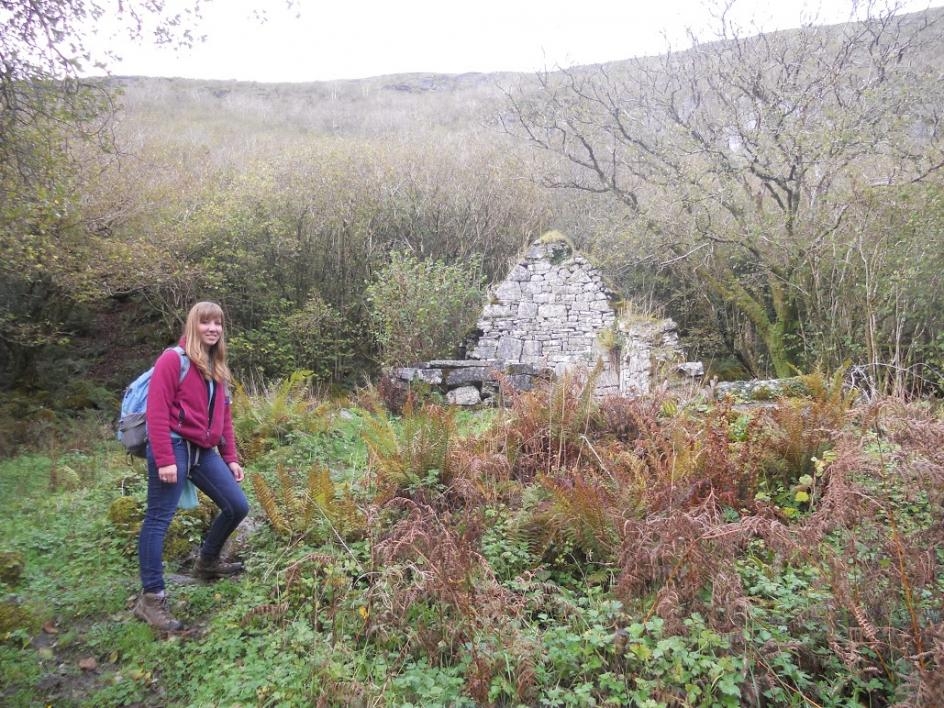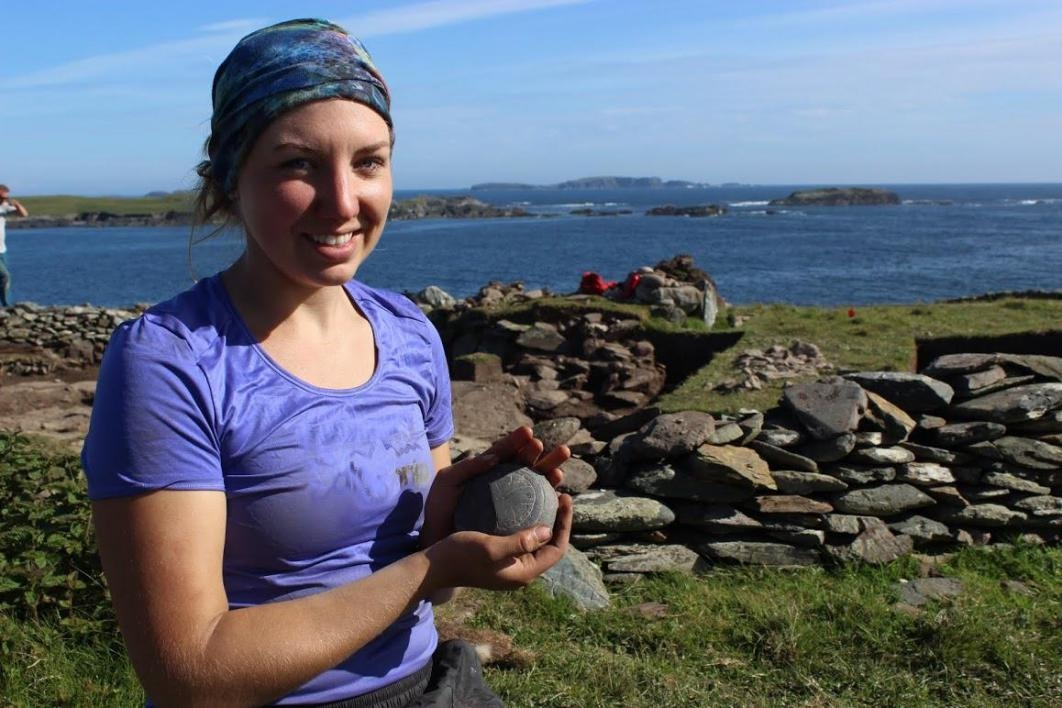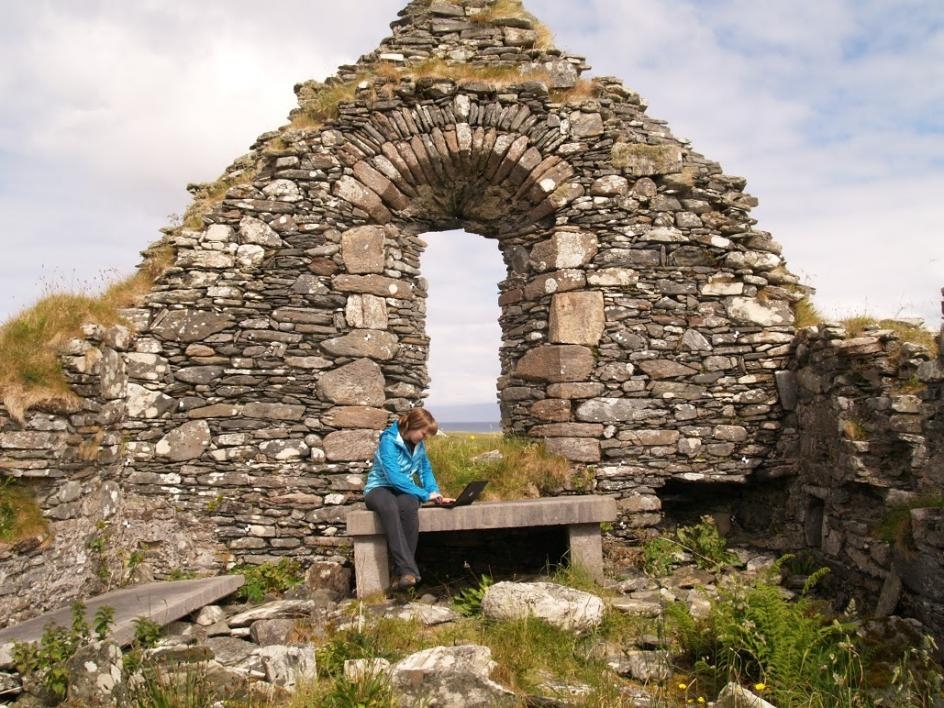Elise Alonzi is taking a fresh look at the history of monasticism in Ireland.
Alonzi, a doctoral student in the School of Human Evolution and Social Change, spent last summer on the Emerald Isle investigating the relics — and the world — of medieval monks.
As a bioarchaeologist, she examines human remains in an archaeological context. The high number of excavated monasteries in the country, and the lack of historical documentation concerning them, made it a natural area of study for Alonzi, who has been involved with the subject since her sophomore year.
When she realized that little isotopic analysis had been done on the monks buried at these monasteries, she decided that pursuing a bioarchaeological approach would allow her to uncover a new perspective on the monasteries’ history.
Filling in the gaps
The textual records of medieval monasteries are somewhat sparse, as creating a historical account of the times was not their main purpose.
“These documents concern mainly the founders, abbots and high-status monks, and it is still unclear how much involvement the local Irish population had in monasticism throughout the medieval period,” Alonzi said.
She hopes to use her research to fill in the gaps the records leave behind.
Alonzi has traveled to Ireland eight times so far, with plans to return next summer. Her work has been supported by travel grants from the Graduate and Professional Student Association and a School of Human Evolution and Social Change pilot study program.
During her last trip, she visited the skeleton collections at the National Museum of Ireland and University College Cork to visually assess the bones she might sample this coming year for her dissertation research. This helped her to design experiments that would answer her anthropological questions while also allowing her to sample human remains without damaging them.
Although some of the skeletons were purposefully excavated from sites of interest, many came from excavations done so that government could stabilize old monasteries.
According to Alonzi, when ancient remains are found in Ireland, the normal process is to study them before reburying them.
“Irish people are currently negotiating their religious identities. This study will help them get a better idea of whether their ancestors participated in monasticism, and it will help us better understand the impact of foreign people on the development of religion on the island.” — Elise Alonzi, bioarchaeology doctoral student
During that same trip to Ireland, Alonzi spent 10 days helping a colleague excavate a mid-nineteenth century house on the small island of Inishark.
“This particular house was directly next to an early medieval prayer station that is associated with an early monastic settlement on the island ... It provided an interesting case study on how the physical remains of medieval monasticism in Ireland were incorporated into daily life in later centuries,” Alonzi said.
The excavations on Inishark are part of a long-term, multi-faceted research project, "Cultural Landscapes of the Irish Coast," combining oral history, historical domestic archaeology and medieval religious archaeology.
Alonzi also presented a paper at the Irish Conference of Medievalists in Dublin last summer. The conference included scholars from many disciplines in addition to archaeology — such as history, linguistics, art and architecture — which provided the opportunity to gather different perspectives on medieval sites.
Her paper discussed the use of archaeological and historical textual evidence to examine medieval diet and farming practices and how they affect medieval skeletons’ isotopic ratios. Alonzi gave the example of an Irish practice called booleyingThe Irish term for transhumance, which is the seasonal movement of people with their livestock between fixed summer and winter pastures..
“Cows would be sent to a summer pasture sometimes quite far from the farmer’s land. So one might expect a local individual to have a slightly different strontium isotopic ratio than if the cows were living at home all year round,” she explained.
Alonzi wants to use this information to better interpret isotopic ratios from medieval skeletons and discern what the isotopic signature is for a local area.
“I am trying to better understand both locals’ participation in monasticism and the extent of social connections between monks buried at the monastery and those at monasteries in different regions, such as Scotland, England and continental Europe,” she said.
The clues in the chemistry
Next summer, using isotopic analysisIsotope analysis is the identification of isotopic signature, the distribution of certain stable isotopes and chemical elements within chemical compounds. (or biogeochemistry), Alonzi expects to be able to estimate the amount of local participation in the monasteries. She wants to try to determine whether a person buried at a monastery is from the local area or not by comparing the isotopes in the skeleton’s bones and teeth to the isotopes found in local plants and soil.
This step involves a lot of background research. She will have to take many soil and plant samples from all across Ireland to gather isotopic data for comparison. As a member of the Irish Isotopes Research Group, she aims to work with other researchers to increase their ecological baseline data. She will perform the analysis at ASU's Archaeological Chemistry Laboratory and the W.M. Keck Foundation Laboratory for Environmental Biogeochemistry.
Alonzi said, “This soil and plant sampling will compose a large section of my dissertation, and I am looking forward to aiding our archaeological interpretations through this work.”
In addition, Alonzi wants to use historical sources and architectural styles to make hypotheses about the connections between monasteries from different regions.
For example, a medieval document might mention that an Irish saint founded two monasteries in different areas. If that’s true, then the monasteries’ architecture will likely be similar. Alonzi could then use isotopic analysis to see if a person buried at one of those monasteries was from the area around that same monastery, or perhaps from the area of the other related monastery.
Alonzi likes to connect with the community and learn what they’re interested in. She has found that the Irish people are extremely interested in their history and that the environment in Ireland is very pro-research.
In the past, she’s cooperated with the Office of Public Works, which is in charge of the medieval monasteries. Office of Public Works architect Kevin O'Brien has mentored Alonzi on the methods of architectural documentation and has brought her to other medieval sites of interest when she visits.
Alonzi hopes that her research will expand the idea of who participated in monasticism in Ireland. Finding evidence of the participation of local people, she explained, will help refute the “Invasion Theory,” which suggests that the Vikings and other invaders brought over religious culture and that locals were not very involved with these innovations.
“Irish people are currently negotiating their religious identities. This study will help them get a better idea of whether their ancestors participated in monasticism, and it will help us better understand the impact of foreign people on the development of religion on the island,” she said.
Additionally, her research would help elaborate on the cultural history in which Ireland takes such pride. Alonzi noted the importance Ireland places on its roots: “Medieval monasteries are all over the place in Ireland, and it is common to have a local GAA (Gaelic Athletic Association) team or an entire townland named after the nearest monastery.”
Written by Mikala Kass, mkass@asu.edu
More Arts, humanities and education

ASU professor's project helps students learn complex topics
One of Arizona State University’s top professors is using her signature research project to improve how college students learn science, technology, engineering, math and medicine.Micki Chi, who is a…

Award-winning playwright shares her scriptwriting process with ASU students
Actions speak louder than words. That’s why award-winning playwright Y York is workshopping her latest play, "Becoming Awesome," with actors at Arizona State University this week. “I want…

Exceeding great expectations in downtown Mesa
Anyone visiting downtown Mesa over the past couple of years has a lot to rave about: The bevy of restaurants, unique local shops, entertainment venues and inviting spaces that beg for attention from…





